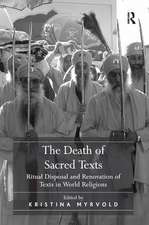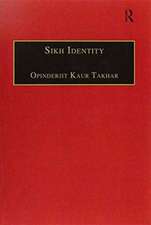Sikhs in Europe: Migration, Identities and Representations
Autor Kristina Myrvold Editat de Knut A. Jacobsenen Limba Engleză Hardback – 17 noi 2011
| Toate formatele și edițiile | Preț | Express |
|---|---|---|
| Paperback (1) | 469.34 lei 43-57 zile | |
| Taylor & Francis – 26 oct 2016 | 469.34 lei 43-57 zile | |
| Hardback (1) | 1066.55 lei 43-57 zile | |
| Taylor & Francis – 17 noi 2011 | 1066.55 lei 43-57 zile |
Preț: 1066.55 lei
Preț vechi: 1300.67 lei
-18% Nou
Puncte Express: 1600
Preț estimativ în valută:
204.11€ • 212.31$ • 168.50£
204.11€ • 212.31$ • 168.50£
Carte tipărită la comandă
Livrare economică 14-28 aprilie
Preluare comenzi: 021 569.72.76
Specificații
ISBN-13: 9781409424345
ISBN-10: 1409424340
Pagini: 360
Dimensiuni: 156 x 234 x 21 mm
Greutate: 0.68 kg
Ediția:1
Editura: Taylor & Francis
Colecția Routledge
Locul publicării:Oxford, United Kingdom
ISBN-10: 1409424340
Pagini: 360
Dimensiuni: 156 x 234 x 21 mm
Greutate: 0.68 kg
Ediția:1
Editura: Taylor & Francis
Colecția Routledge
Locul publicării:Oxford, United Kingdom
Notă biografică
Knut A. Jacobsen is the author or editor of around 20 books. He was co-editor with Selva J. Raj of South Asian Christian Diaspora published by Ashgate 2008. Kristina Myrvold is the editor of the book The Death of Sacred Texts: Ritual Disposal and Renovation of Texts published by Ashgate in 2010.
Recenzii
'...The editors deserve praise for bringing together this set of well-researched papers in a single volume. The book fills a major gap in the knowledge about Sikh communities in several European countries, and is a major contribution to the study of international migration, religion, and multiculturalism... Highly recommended...' Choice '... a volume of interest not only to scholars of migration, religion and South Asia, but also to European Sikhs - who to my experience have a keen interest in their own history and heritage... this volume is exciting and bodes well for the next outputs of the Sikhs in Europe network, such as Sikhs Across Borders (Jacobsen and Myrvold 2012), and an anticipated focus of future work on inter-generational change and European Sikh youth.' Nordic Journal of Migration Research ’Unlike the larger UK Sikh community, which has been well studied since the 1960s, this is the first comprehensive account of the growing Sikh presence in continental Europe. On this criterion alone it is a landmark publication. [...]By bringing out this refreshing and timely publication on Sikh communities in Europe, which hitherto had been largely invisible, little known and understood despite their unsurpassed contribution during WW1 and WW2, the editors have done a great service to both the fields of Diaspora Studies and Sikh Studies.’ Punjab Studies
Cuprins
Introduction: Sikhs in Europe; I: Sikhs in Northern and Eastern Europe; 1: Institutionalization of Sikhism in Norway: Community Growth and Generational Transfer; 2: The Sikh Community in Denmark: Balancing between Cooperation and Conflict; 3: The Swedish Sikhs: Community Building, Representation and Generational Change; 4: Sikhs in Finland: Migration Histories and Work in the Restaurant Sector; 5: The Sikhs in Poland: A Short History of Migration and Settlement; II: Sikhs in Southern Europe; 6: Mirror Games: A Fresco of Sikh Settlements among Italian Local Societies; 7: “Did You Get Papers?” Sikh Migrants in France; 8: Caste, Religion, and Community Assertion: A Case Study of the Ravidasias in Spain; 9: Sikh Immigrants in Greece: On the Road to Integration; III: Sikhs in the United Kingdom and Ireland; 10: Sikh Diversity in the UK: Contexts and Evolution; 11: Sikh-ing Beliefs: British Sikh Camps in the UK; 12: The Valmiki, Ravidasi, and Namdhari Communities in Britain: Self-representations and Transmission of Traditions; 13: The Sikh Diaspora in Ireland: A Short History
Descriere
Sikhs in Europe are neglected in the study of religions and migrant groups: previous studies have focused on the history, culture and religious practices of Sikhs in North America and the UK, but few have focused on Sikhs in continental Europe. This book fills this gap, presenting new data and analyses of Sikhs in eleven European countries; examining the broader European presence of Sikhs in new and old host countries. Focusing on patterns of migration, transmission of traditions, identity construction and cultural representations from the perspective of local Sikh communities, this book explores important patterns of settlement, institution building and cultural transmission among European Sikhs.












